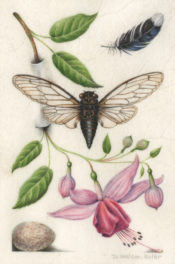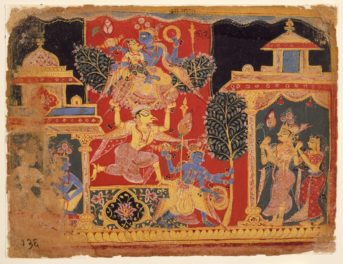
Inside In Focus: Ansel Adams. Artwork © The Ansel Adams Publishing Rights Trust
A little-known fact about Ansel Adams is that before he was a genius photographer, he was poised to be a genius piano player. In fact, he was so dedicated to music that starting when he was 12 years old, he would practice for more than six hours a day—a dedication that continued well into his adulthood, when leaving the piano for photography would be a major life decision. The skill and sensibility he developed for the technical and precise coordination of chords, sounds, and tones would carry a lifelong resonance in his dedication to exploring the chords and tones of black, white, and grey in his photographs.
Adams has said, “The piano has 88 keys, and you have to be able to play all of them. And the range of white to black is analogous to the 88 keys and you have to be able to play all 88 keys in that palette from white to black.” His musical approach to photography contributes to the sense of richness in his images, and this tonal quality carried over to their composition as they captured moments that ring out and reverberate. Adams’s longtime assistant commented on this belllike quality in his photographs and said, “to me, his best photographs are like his playing on the piano. They linger in your mind’s eye and your ear and they stay with you.”
For our next installment of this summer’s Friday Flights playlist series—a digital component of our monthly on-site events curated by local creatives—our friend Liz Tooley at Permanent Records has chosen a series of songs for In Focus: Ansel Adams, which is open through July 20th at the Getty Center. These songs feature an epic and rich range of tones and a complex sense of composition echoed in Adams’s photographs. We invite you to bring your headphones to the gallery, pull this playlist up on your smart phone, and consider the music together with Adams’s photographs, as part of our ongoing series considering art and music together.
The Friday Flights Permanent Records Playlist
Sandy Bull, “Blend”—Interventions (1965)
Thought to be one of the first to blend Eastern and Western music in the form of extended raga style compositions, Sandy Bull was making unique guitar, sitar and ubo at a time when no one was listening. He was a student of jazz, folk and Indian music, to name a few of his influences, but his talents go beyond these genres and his work is more well-known today than it ever was in the 60’s-70’s.
Sir Richard Bishop, “Zurvan”—While My Guitar Violently Bleeds (2007)
Bishop is best known as a member of the Sun City Girls which he founded with his brother Alan Bishop in 1981. In 2005, Bishop began working as a solo artist drawing from deep world-wide roots from his many travels with Sun City Girls. While My Guitar Violently is made up of three extended compositions for acoustic and electric guitar. “Zurvan” is what many find to be the most reminiscent of the old guard of experimental folk guitarists.
John Fahey, “Desperate Man Blues”—Legend Of Blind Joe Death (1959)
Fahey is considered one of the best and earliest leaders of the ’60s avant, experimental guitar movement. Fahey developed a picking style by listening to classical guitar, yet was heavily influenced by early folk and blues traditionals. While at school in Berkeley, Fahey issued his first album himself on his own imprint, Takoma Records, convinced that no proper label would be interested in his work. One side of this record contained Fahey’s name, while the other side was credited to Blind Joe Death (also Fahey using an alias). Ever the character, Fahey loathed the hippy folk movement he found himself aligned with while at Berkeley and soon left for L.A. to join the folklores master’s program at UCLA, where he ultimately found a more like-minded underground folk scene.
Jack Rose, “Black Pearls from the River”—Raag Manifestos (2004)
A member of the punk-influenced noise/drone band Pelt, Jack Rose has also maintained a hearty solo career, releasing over a dozen albums. In 1999, Rose was fired from his job at a coffee shop and was able to collect unemployment, which allowed him to work soley on music and rapidly improve his acoustic guitar skills. His third release, Raag Manifestos was named one of the “50 Records of the Year” by Wire magazine. Sadly, Rose died young from an apparent heart attack at the age of 38.
Omar Khorshid, Extract from movie Guitar of Love (1972)
Omar Khorshid was not only a famed guitarist in the Middle East, but also a huge movie star—though he’s received scarcely any international recognition. Born in Cairo in 1945, the young talent would quickly find himself a player in Egypt’s cultural reinvention. Khorshid was a household name and was featured heavily on live TV and live radio recordings. He’s been hailed as the greatest Arabic guitarist the world has ever known. Richard and Alan Bishop’s label, Sublime Frequencies, would release a limited-edition compilation of Khorshid’s work entitled Guitar El Chark in 2010 to much acclaim.
Roy Montgomery, “Jaguar Meets Snake”—Temple IV (1995)
A New Zealand guitarist and composer, Montgomery is best known for his work with the indie rock band The Pin Group. His solo work is drastically more experimental with lo-fi, avant folk elements which layer track after track of droning, echoing guitar sounds. Montgomery has been recording acoustic music since 1982, mainly drawn to composing alone which he says he attributes to being an only child.
_______
Friday Flights continues all summer at the Getty Center. The event is free; parking is $10 after 5pm.




Hi Sarah,
Nice work. Regards. Roy
NO COMMENT